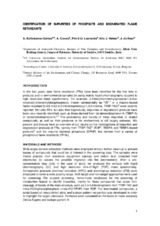Mostrar el registro sencillo del ítem
Identification of impurities of phosphate and brominated flame retardants
| dc.contributor.author | Ballesteros-Gómez, A. | |
| dc.contributor.author | Covaci, A. | |
| dc.contributor.author | Leonards, Pim E.G. | |
| dc.contributor.author | Reiner, Eric J. | |
| dc.contributor.author | de Boer, J. | |
| dc.date.accessioned | 2018-10-17T10:37:35Z | |
| dc.date.available | 2018-10-17T10:37:35Z | |
| dc.date.issued | 2018 | |
| dc.identifier.uri | http://hdl.handle.net/10396/17311 | |
| dc.description.abstract | In the last years, new flame retardants (FRs) have been identified for the first time in products and in environmental samples by using mainly liquid chromatography coupled to high resolution mass spectrometry. For example, 2,2-bis(chloromethyl)propane-1,3-diyl-tetrakis(2-chloroethyl)bis(phosphate), known commercially as “V6”,1 or a triazine-based flame retardant [2,4,6-tris(2,4,6-tribromophenoxy)-1,3,5-triazine, TTBP-TAZ]2 were recently reported. Not only FRs, but also their byproducts, impurities or degradation products have been very recently identified, such as those derived from tetrabromobisphenol-A (TBBP-A) or tetrabromobisphenol-S.3,4 The persistency and toxicity of these impurities or related compounds, as well as their presence in the environment is still largely unknown. We present and discuss here an overview of our results on the investigations of impurities and degradation products of FRs, namely from TTBP-TAZ2, RDP5, TBBPA and TBBPA-based products6 and the impurity diphenyl phosphate (DPHP) that derives from a variety of phosphorus flame retardants (PFRs) | es_ES |
| dc.format.mimetype | application/pdf | es_ES |
| dc.language.iso | eng | es_ES |
| dc.rights | https://creativecommons.org/licenses/by-nc-nd/4.0/ | es_ES |
| dc.subject | Flame retardants | es_ES |
| dc.subject | FRs | es_ES |
| dc.title | Identification of impurities of phosphate and brominated flame retardants | es_ES |
| dc.type | info:eu-repo/semantics/conferenceObject | es_ES |
| dc.relation.projectID | Gobierno de España. RYC-2015-18482 | es_ES |
| dc.rights.accessRights | info:eu-repo/semantics/openAccess | es_ES |

